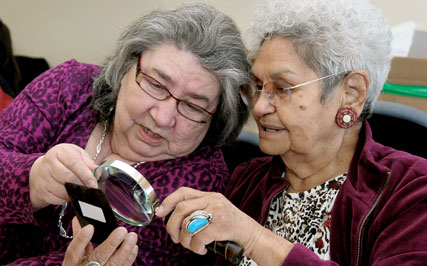Culture
Tintype treasures

The photographs, holding court in a classroom at the Cultural Resources Department, brought back memories of a time gone by.
"I didn't even know they existed until my parents passed on," said Tribal Elder Barbara Danforth of Tigard. She inherited the treasures some two years ago from her mother, former Tribal Elder Bernice McEachran.
"These are some of the oldest photographs and tintypes we've ever seen," said Tribal Elder June Olson, former manager of the Cultural Resources Department.
Along with a handful of other Tribal Elders, Olson poured over the treasures originally from the estate of former Tribal Elder Victoria Howard, Danforth's great-grandmother.
They looked for people and places they recognized. They were awed by the age and rarity of what they saw.
"I really think that might be (former Tribal Elder) Mose Allen," said Olson of one picture.
The intriguing cache of almost 150 pieces, including some 20 letters and a huge basket, date back as far as the late 1800s and as close as the 1950s. They include pictures of people for whom the Tribe has no other photographic record, Olson said.
Tribal Elder Kathryn Harrison had never before seen one photo of her oldest brother, Harold, as a baby.
One of the letters, from the 1950s, "is telling grandma to get down here (to Grand Ronde) to get on the rolls," Danforth said.
Victoria Howard's chants, stories and creation myths have made her the subject of books and academic studies.
"My intent was to share these pictures, and to see if anyone knows who they are. I also wanted Tribal members to gain access to family member pictures that they didn't have," said Danforth.
"(Howard) worked with (University of Washington anthropologist) Melvin Jacobs," said Danforth's daughter, Sara, of Portland. "Howard's work is in both UW and Smithsonian collections."
Sara's interest in her great-great-grandmother has landed her on the board of a North Carolina-based organization dedicated to preserving indigenous languages and verbal traditions.
Here in Grand Ronde, Barbara Danforth has allowed the Cultural Resources Department to scan all of the pieces in the collection.
"I'm just very proud of her contributions to Chinuk language," said Barbara. "She was one of the last few that knew the language and she recorded it on disks. I think that's important for our sustainability."
"I wish the last generation was still around," said Harrison, "especially the Hudson girls." She inspected picture after picture with a large magnifying glass. Some were so faded that she could barely make out a face.
For those with clear faces but no known identity, Harrison added, "I'll bet (former Tribal Elder) Rosetta (LaBonte Manangan) would remember.
"This is just the beginning. Next, we're going to take the copies around and see who recognizes these people."
Many pictures, however, had already been recognized by members of the group of Elders looking through them on Friday, March 25. In addition to those noted, the Elders included Olson's sister, Joyce DeHart, and mother, Marion Davidson, as well as Peachie Hamm, Dale and Ivan Langley, Marilee Norwest and Laura Gleason.
"There's a lot of information here about her family and neighbors," said Olson, "and our culture. These are the experiences of the first 50 years on the Grand Ronde reservation."
Some of the identified tintypes and pictures show the following early members of the Tribe, all passed on now: Henry Curl, John Silas, Rena Hoffer, Sally Hudson, Scott Jones, Susette Norwest, Paul Lafferty, Charlie Wacheno, Lillie Tipton, Joe Day, Frank Wheeler, John Wheeler and many others.
"These are the children of the first generation at Grand Ronde," said Olson.
What makes the collection so valuable, she added, is that "a lot of the folks identifying these pictures are directly related or more intimately connected to Victoria."
Three large oval pictures that look like hand-colored reproductions of photographs from 1919 show Howard and her husband, Eustace, along with Danforth's grandmother, former Tribal Elder Agatha Howe.
"This is the photo that it came from," said Sara Danforth, referring to the hand-colored reproduction of Victoria Howard. The original was maybe 3-by-5 inches.
"It's amazing," said Sara. "So cool."
"That's the Indian agent," said Olson. "And these are the Hudsons."
Some mysteries, however, may never be solved.
"This one says something about a dog dying," said Olson. She looked on the back. "The year is 1919," she said, "but I don't see a dog in the picture."
